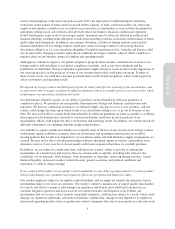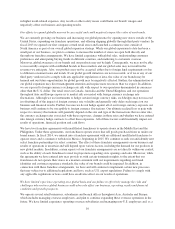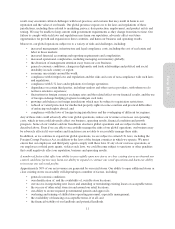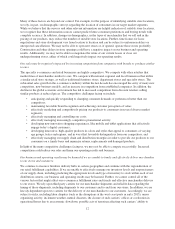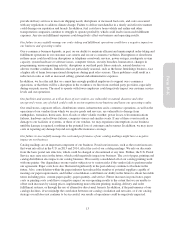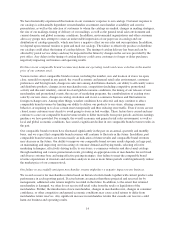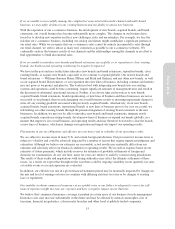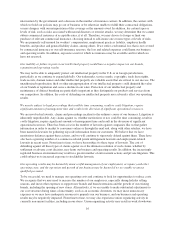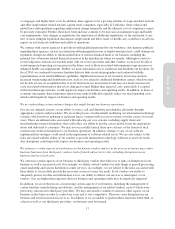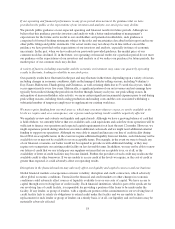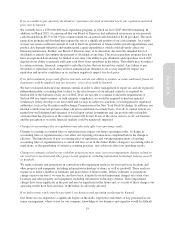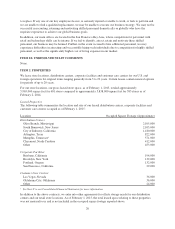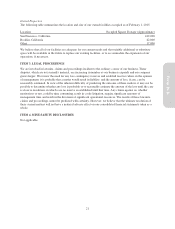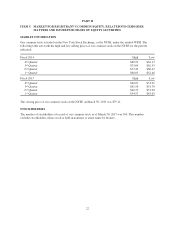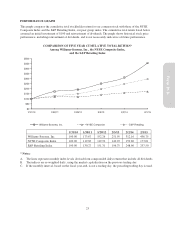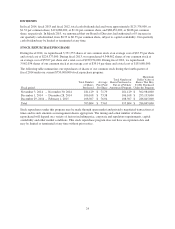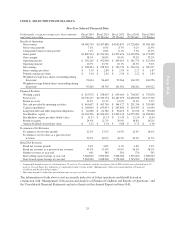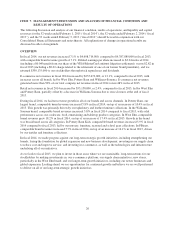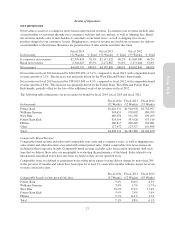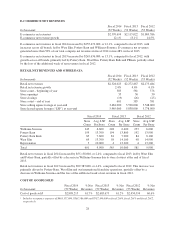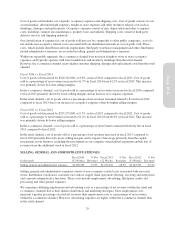Pottery Barn 2014 Annual Report Download - page 33
Download and view the complete annual report
Please find page 33 of the 2014 Pottery Barn annual report below. You can navigate through the pages in the report by either clicking on the pages listed below, or by using the keyword search tool below to find specific information within the annual report.
If we are unable to pay quarterly dividends or repurchase our stock at intended levels, our reputation and stock
price may be harmed.
We currently have a $750,000,000 stock repurchase program, of which we have $287,000,000 remaining. In
addition, in March 2015, we announced that our Board of Directors had authorized an increase in our quarterly
cash dividend from $0.33 to $0.35 per common share for an annual cash dividend of $1.40 per share. The stock
repurchase program and dividend may require the use of a significant portion of our cash earnings. As a result,
we may not retain a sufficient amount of cash to fund our operations or finance future growth opportunities, new
product development initiatives and unanticipated capital expenditures, which could adversely affect our
financial performance. Further, our Board of Directors may, at its discretion, decrease the intended level of
dividends or entirely discontinue the payment of dividends at any time. The stock repurchase program does not
have an expiration date and may be limited at any time. Our ability to pay dividends and repurchase stock will
depend on our ability to generate sufficient cash flows from operations in the future. This ability may be subject
to certain economic, financial, competitive and other factors that are beyond our control. Any failure to pay
dividends or repurchase stock after we have announced our intention to do so may negatively impact our
reputation and investor confidence in us, and may negatively impact our stock price.
If we fail to maintain proper and effective internal controls, our ability to produce accurate and timely financial
statements could be impaired and our investors’ views of us could be harmed.
We have evaluated and tested our internal controls in order to allow management to report on, and our registered
independent public accounting firm to attest to, the effectiveness of our internal controls, as required by
Section 404 of the Sarbanes-Oxley Act of 2002. If we are not able to continue to meet the requirements of
Section 404 in a timely manner, or with adequate compliance, we would be required to disclose material
weaknesses if they develop or are uncovered and we may be subject to sanctions or investigation by regulatory
authorities, such as the Securities and Exchange Commission or the New York Stock Exchange. In addition, our
internal controls may not prevent or detect all errors and fraud on a timely basis, if at all. A control system, no
matter how well designed and operated, is based upon certain assumptions and can provide only reasonable
assurance that the objectives of the control system will be met. If any of the above were to occur, our business
and the perception of us in the financial markets could be negatively impacted.
Changes to accounting rules or regulations may adversely affect our operating results.
Changes to existing accounting rules or regulations may impact our future operating results. A change in
accounting rules or regulations may even affect our reporting of transactions completed before the change is
effective. The introduction of new accounting rules or regulations and varying interpretations of existing
accounting rules or regulations have occurred and may occur in the future. Future changes to accounting rules or
regulations, or the questioning of current accounting practices, may adversely affect our operating results.
Changes to estimates related to our cash flow projections may cause us to incur impairment charges related to
our retail store locations and other property and equipment, including information technology systems, as well
as goodwill.
We make estimates and projections in connection with impairment analyses for our retail store locations and
other property and equipment, including information technology systems, as well as goodwill. These analyses
require us to make a number of estimates and projections of future results. If these estimates or projections
change or prove incorrect, we may be, and have been, required to record impairment charges on certain store
locations and other property and equipment, including information technology systems. These impairment
charges have been significant in the past and may be significant in the future and, as a result of these charges, our
operating results have been and may, in the future, be adversely affected.
If we fail to attract and retain key personnel, our business and operating results may be harmed.
Our future success depends to a significant degree on the skills, experience and efforts of key personnel in our
senior management, whose vision for our company, knowledge of our business and expertise would be difficult
19
Form 10-K


